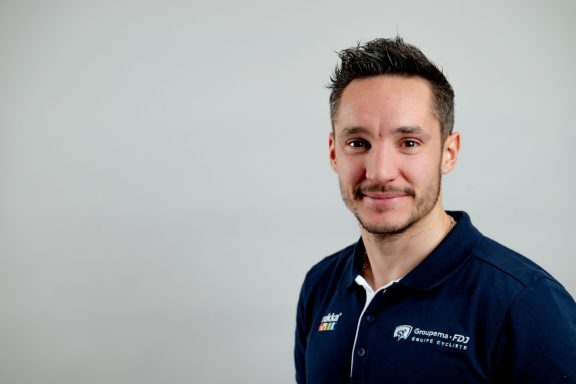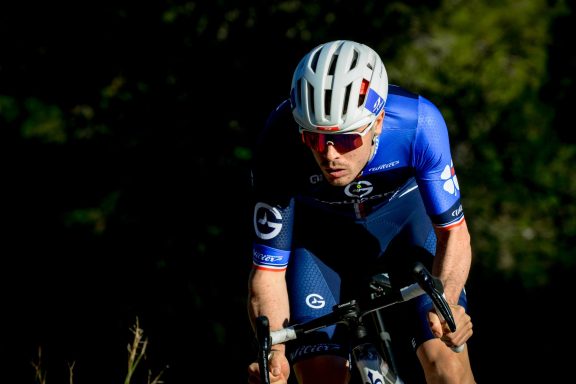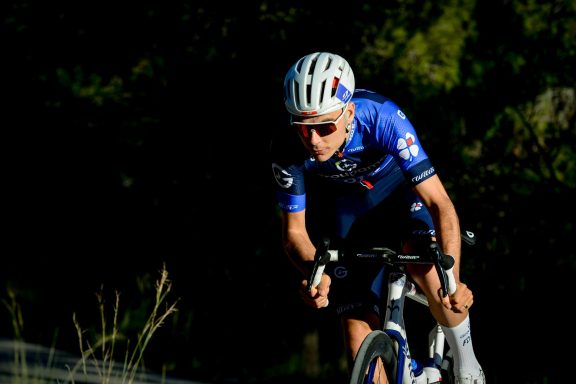Since the start of the break caused by the coronavirus pandemic, the Groupama-FDJ cycling team’s sport and performance departments have been able to give their take on the situation. Today, it is up to the medical’s one, through the voice of its director Jacky Maillot, to raise the issues connected to the current period and more specifically riding on trainers. It is also an opportunity to learn more about the functioning of the team’s health department.
Jacky, the riders have got back on trainers for a week. What are the main risks of this activity?
The first one can be dehydration. When you train for one or two hours a day, you sweat a lot and lose a lot of minerals. To avoid this, we created a note with the trainers to provide hydration advice to the riders, whether it would be for minerals or electrolytes. The second risk would be to make, in particular through new software, unusual, intense and extended efforts because you are caught up in the game of virtual racing. Riders can reach quite high intensity levels and the trainers, unlike the road, don’t permit a rest period or “freewheeling”. If these efforts are combined with insufficient carbohydrate intake, for example, you can put your immune system at risk. This is also the case with dehydration. In this period of viral epidemic, this is something we really want to be careful about. We want to enable our riders to keep their good physical condition, or get it back, but without compromising their immune system, which is a priority.
“The risk of overtraining is not high”
Are there other traps to avoid?
In addition to staying well hydrated, you should avoid making efforts on an empty stomach. When there is no intake of carbohydrate drinks and nutrients for muscles and the intestine, the body is mistreated and secretes a hormone, cortisol, which is well known for its immunosuppressive effects. If you are not careful and do 1h-1h30 on the trainers on an empty stomach in the morning in order to try not to gain weight, which is another problem in this lockdown period, you risk weakening your immune system and therefore to be very vulnerable in case of contact with the virus.
Is there also a risk of overtraining on stationary trainers?
It’s not necessarily about overtraining. That being said, the rider has habits of eating and hydrating on the road. On the trainers however, he can sometimes forget about it thinking that it will not last long or that there will not be too high intensities. But then, he gets into it… And when he produces high intensities over long periods of time, this is when he must be very careful about intake of carbohydrate drinks and electrolytes. He sweats a lot; he loses a lot of iron, magnesium, sodium, and potassium. His homeostasis (metabolic balances) can therefore be unbalanced and lead to immune deficiencies. In this case, he gets very vulnerable to microbes, and we already know that in normal times, the heavy training loads of a sportsman weaken his immune system. The risk of overtraining is not high on the stationary trainers because we quickly get to the saturation point. However, repeating very intense workouts can indeed put the immune system at risk.
What are the ideal conditions for the stationary trainers practice?
It all depends what context you want to practice it in. When you just want to get back to training and do some workloads, there is not point of being demanding with the conditions. Most importantly, the rider must feel comfortable whether he’s outside or in his garage. However, it is still necessary to have a bit of ventilation if he is indoors, either by standing next to the window or by using a fan. Otherwise, you breathe stuffy air and this creates toxins more quickly. Body temperature rises very fast. We know that after 45 minutes, it already reaches 38.5-39°C because of the effort that is produced. Knowing that this type of effort is likely to be repeated, the rider shouldn’t create imbalances that could set in for several weeks and that you would pay later. For now, comfort is the priority, but it is possible that the rider will find himself in slightly more extreme conditions in a few weeks to get him used to efforts in hot conditions. When we’ll resume racing, it will certainly be summer, so we will have to be acclimatized. Also, the brightness is not necessary but it is for sure more pleasant and mentally stimulating to ride on the trainers outside when the weather is nice.
“Some injuries can occur more easily”
Are there specific risks of injury?
You can indeed put yourself at risk of injury, particularly tendinopathy, tendinitis, when you don’t have a suitable nutrition. There is also a risk of tendinomuscular damage when you don’t hydrate enough. You also have to be careful about all the bike’s settings, which you also do in normal times. Riders give so many pedal strokes that the slightest defective adjustment can lead to injuries, like tendinopathies around the knee, low back pain and gluteal muscle pain. These are the usual risks but the stationary trainers increase them due to the lack of positions changes. So, of course, the injuries mentioned above can occur more easily. The quality of the saddle is therefore very important, in particular to avoid all lesions of the perineum, but also to work on all the gluteal muscles, which don’t get massage at the moment. Because of that, we have also set up, with our physiotherapists, video sessions of core strength, general physical preparation and above all stretching. They are reminded what are the good moves for stretching since they cannot benefit from recovery massage at home at this time.
We understand that the general physical preparation should not be left apart in this period.
It is indeed important in many ways. There is a need for sufficient abdominal, gluteal and lumbar strengthening for two reasons. Firstly, to prevent injuries. If a rider is not strengthened enough, his pelvis endures multiple movements with each pedalling effort, which can cause pain on muscles and ligaments and become very harmful in a race. A lack of general physical preparation can also lead to pain in the gluteal muscles but also in piriformis muscles, which can potentially cause sciatica, which is very complicated to solve in addition to being troublesome. At the moment, there is a double interest in the general physical preparation because all these muscles (thighs, calves, gluteal) are not massaged. The more the riders will be strengthened, the less they will use these gluteal muscles and the less the will have sciatic pathologies or gluteal pain. It is therefore important to stay fit. We usually do ‘GPP’ sessions during training camps in December and January. Riders have less time for it afterwards, but many still do it to stay in shape. We took this opportunity to give a reminder on core strength and stretching, which keep the riders busy in addition to being useful. It also creates sort of a dynamic between everyone and the medical service.
“The team is trying to implement things in every area”
In the current situation, is your support towards the riders even more advanced than usual?
We have prepared several things for them, such as general physical preparation and stretching instructions as I have just explained. We obviously remain available for them for any question or request, and we also offer them more psychological support. During this period, some may feel a little more vulnerable, which is why a psychotherapist and a mental coach are there to help them if necessary. We also take advantage of this period to set up dietary support at two levels. For both the Conti and the WorldTeam, we are starting to carry out nutritional evaluations in order to correct some things if necessary. At the same time, they are given advice on how to avoid gaining weight, which is also a problem because they do less exercise. Usually, they can go out for up to six hours, so the energy expenditure is really high. It is obviously less on the trainers. Dietetics is important to maintain good health with strong immune system during an epidemic. The nutritional quality of what the rider will eat during or outside of the effort will determine his immune system’s state and performance. This is something well known to the most experienced members of the team, to whom we just give little reminders and suggest taking food supplements. For the youngest, whether they are from the Conti or from the WorldTeam, we emphasise the good practices and the support is more extensive. Emails have been sent to them to remind them of the importance of dietary supplements and certain nutrients in shaping a better immune system. We were also able to start analysing their daily calorie rations to find out if everything was well balanced in terms of quantity and quality.
Are there any changes in the relationship between the medical service and the rest of the team given the context?
The relationship is the same than usual, it has not decreased. On the opposite, there are more exchanges. For example, I had a video meeting with Fred Grappe (performance director) and a cook in order to provide culinary advice to our young guys from the development team. They get in our team at the age of 18-19 and do not necessarily know how to cook. We also want to bring them these kinds of skills and this is an opportunity to implement all of this. As soon as they will return to Besançon, they will therefore have lessons to learn how to cook food and know the nutritional quality of it. Our relationships with all services, and especially with the performance department, remain very strong. We exchange on a daily basis. For example, eleven workouts have been defined. From there, we established nutritional advice for each workout. We try to take advantage of all this time to do things that we don’t have time to do in normal times, because of racing and traveling. Generally speaking, I think this break could bring some good as the team is trying to implement things in every area. It can also strengthen ties and show the riders that they are not left behind, that everyone is committed to support them as much as possible and make them as comfortable as possible. This is an important period and I think we can come out of it with an even more united group and team spirit, if there were ever a need.
“Anticipate the impact of workloads on the rider’s health”
In “normal” times, how does the medical service operate within the team?
When a rider has a health problem, he gets in touch with me. There are then two options. Either I can fix the problem and it doesn’t have an influence on his performance, or the problem can affect his participation in a race. I then notify both the performance department and the sports management that the rider is unavailable for a certain period of time. Information must be brought in as quickly as possible. Then, it is up to me to exchange with the rider’s trainer and sports director to adjust, depending on the injury or illness, the training load, which can be zero or progressive. We communicate urgently when there is a scheduled competition and we then move towards very constructive and regular discussions between the three departments to monitor the rider’s recovery.
Is it difficult to find the right balance between health and performance?
To be successful you obviously have to be in good health, this is the sine qua non condition. It is therefore up to us, within the medical service, to make sure of it with the riders. But we also know that to be successful, you must accumulate important training loads, which can be harmful to health at some point. It is up to us to study and monitor all of this, which we do thanks to questionnaires, interrogations and quite extensive biological results. We are trying to study the markers that show that the impact of the workload is satisfactory, or on the opposite too high. In the latter case, we get in touch with the coach and the sports director to tell them that a given rider is in the “yellow-orange” zone, that he must therefore ease off, skip a few races so that he can rest and get competitive again. We must define control markers to be able not to bring our riders towards overtraining. Because once this level is reached, it’s a disaster for the rider, as he must stop racing for 3 to 6 months. Within the medical service, we must anticipate the impact of workloads on the rider’s health. As soon as it exceeds certain areas, it can lead to injury or infectious disease. I’ve talked a lot about the immune system, but that’s because it’s very important to us. If a rider catches a virus, whatever the virus may be, he no longer performs well. A virus can be completely harmless for anyone but lead to several weeks off for a rider. It is therefore up to us to keep him healthy so that he can, later on, perform well.



No comment